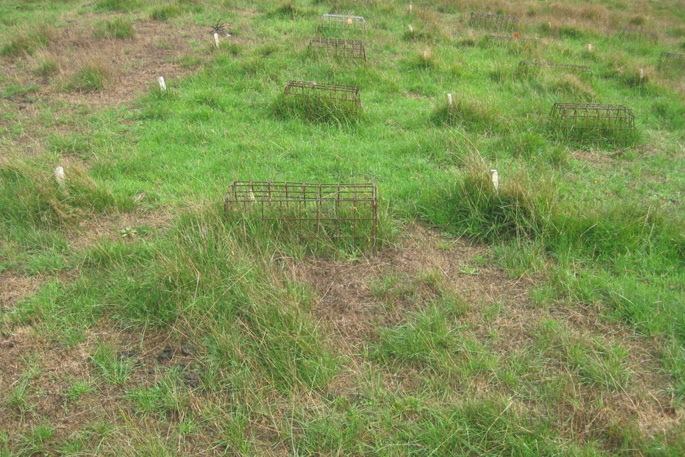 |
Fert Options with Robin Boom Agronomic Advisory Services |
For the past four years I have been conducting a lime trial on Piquet Hill farm at Te Akau.
The trial was initially set up as a Beef + Lamb New Zealand, Farmer Initiated Technology Transfer (FITT) trial which ran for 12 months to investigate what farmers called a ‘sweetening’ of the pastures following lime applications.
The trial site was very acidic (pH 5.1) and lime was applied to 2 square metres plots at four rates – 1.25 tonnes per hectare, 2.5 tonnes per hectare, 5 tonnes per hectare and 10 tonnes per hectare, over four replicates.
Grazing height, dry matter production figures using pasture cuts under cages, pasture species changes, brix measurements, dissections and soil and feed laboratory tests were performed to try and identify the cause of improved pasture palatability.
From the first year’s results, the only time of year the feed value in terms of ME, crude protein, digestibility etc improved with increasing rates of lime was autumn, after a drought. There were, however, huge dry matter production increases with increasing rates of lime, from 20 per cent at the lower rates up to 50 per cent at the highest rate the first year. There were also notable pasture species changes with more ryegrass and clover species and less weeds as lime rates increased.
As the FITT trial only ran for a year, Rorison and Avoca Lime companies continued to sponsor this trial to see how the effects would continue, and this winter the trial will stop after collecting four years of data. What the results have shown is that the effect of lime keeps improving over time, and for the third year, the highest rate of lime grew on average 93 per cent more dry matter than the control plots.
Also the soil test changes have taken several years to fully come through. In the first year, the pH on the 10 tonnes per hectare treatments only lifted from 5.1 to 5.6, the second year to 5.8 and last year to 6.1 which is where you would expect this rate of lime to be, since every tonne of lime should lift the pH by 0.1.
These results fly in the face of a lot of historical lime research which showed average increases in pasture production of 8-12 per cent from lifting a soil pH of 5.1 to 6.0, such as the graphs found on page 6 of Doug Edmeades Fertiliser Review Issue 40 in Spring 2018 or that found on page 7 of the Ballance North Island Grow publication Autumn 2018.
One of the reasons for such a phenomenal response is that this site had very high available aluminium levels which is toxic to some pasture species and inhibits root growth. This site is also prone to summer droughts, so with lime being able to mitigate the aluminium toxicity, root development would have improved, giving greater drought resilience and also these roots will have been able to exploit previously untapped nutrients in the soil. Within three weeks of the lime being applied to the plots, the farm owner could visually see responses under the cages, to lime which would also suggest a biological response, and the whole nitrogen cycle and nutrient recycling would have got a massive kick-start.
The graph below shows the total dry matter production figures over the first three years the trial has run.

|
Pasture Species |
Ryegrass |
Sweet Vernal |
Chewings Fescue |
White Clover |
Subterranean Clover |
Lotus Minor Sp |
Weeds |
|
Control |
29 |
44 |
10 |
6 |
16 |
7 |
47 |
|
1.25 ton |
33 |
47 |
1 |
2 |
29 |
7 |
41 |
|
2.5 tonne |
60 |
48 |
2 |
4 |
24 |
12 |
12 |
|
5 tonne |
73 |
45 |
1 |
16 |
25 |
4 |
13 |
|
10 tonne |
79 |
47 |
0 |
21 |
22 |
4 |
5 |
What is interesting in this data is that the dominant native grass – sweet vernal - was present in equal amounts over all treatments.
In terms of economics, assuming the lime cost $30 per tonne, application by plane cost of $65 per tonne and cartage cost of $25 per tonne, the cost per kilogram of dry matter over the three years was just under $0.05 at the lowest rate of lime up to just over $0.10 at the highest rate. Where lime is applied by truck instead and application cost drops to $20 per tonne, then the overall cost per kg of dry matter drops to under $0.03 at the low lime rate to just over $0.06 for the high rate which is very cheap dry matter. Because the limed pasture has a higher legume base, the fattening and milking value for stock grazing this pasture also improves. I should however stress that these results are specific to this site, and that such impressive responses should not be expected everywhere with pH levels around 5.0. It also raises the prospect of, rather than just lifting the soil pH to around 5.6 on hill country, there can be possible economic gains getting it closer to 6.0 on some hill country properties.
Sometime this year the trial sponsors will be organising a field day to further discuss these results where attendees can see for themselves the differences in pastures between the various plots.
Below is a photo taken February 2018 after a dry period. In the foreground is a control plot, next to a 10 tonne per hectare plot, then a 2.5 tonne per hectare, a 1.25 tonne per hectare plot and a 5 tonne per hectare plot at the end. Note the open pastures to the left of the plots which is unlimited.



0 Comments
Leave a Comment